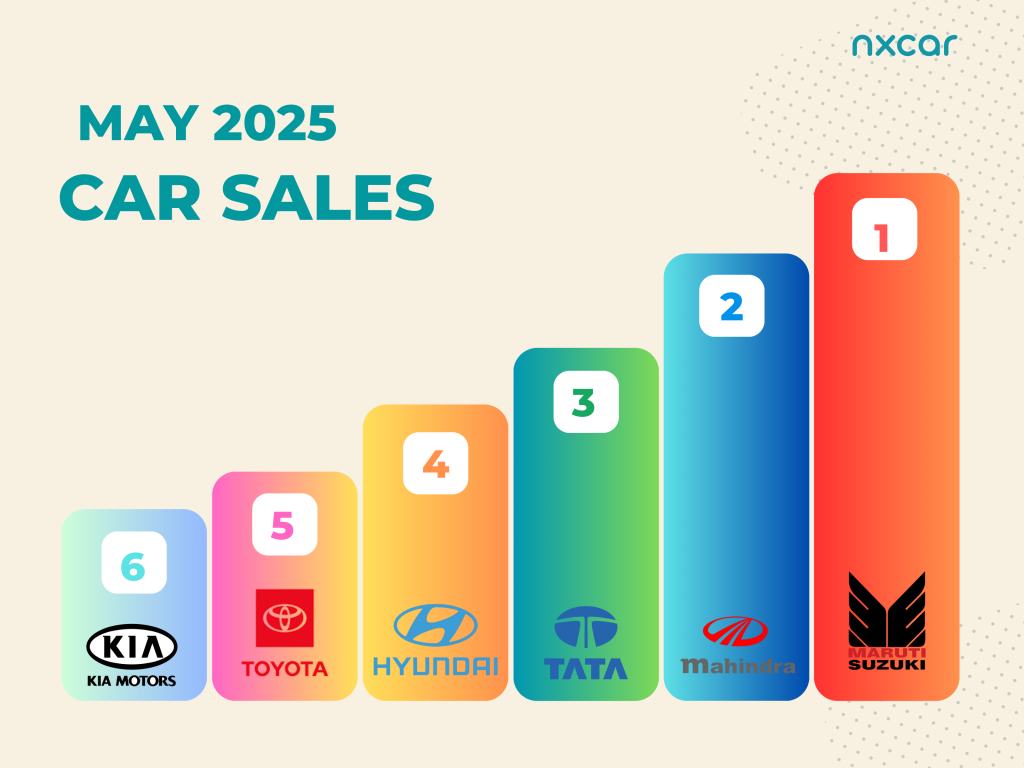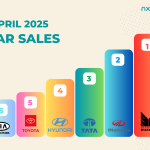India’s automotive market in May 2025 showcased a complex landscape of shifting preferences, brand repositioning, and evolving product strategies. Following a relatively stable April, May saw certain manufacturers build on their momentum while others fell behind, revealing the deep impact of portfolio relevance, SUV penetration, and consumer sentiment in a competitive space.
In this report, we dive deep into May 2025 Car Sales, with a granular analysis of all 14 OEMs, detailed YoY and MoM comparisons, and a broader view of the Indian passenger vehicle segment’s trajectory.
May 2025 Car Sales: Modest Growth Amid Realignment
May 2025 saw total passenger vehicle sales touch approximately 3,49,791 units, marginally lower than April 2025 but up compared to May 2024’s estimated 3,37,372 units, indicating a YoY growth of around 3.7%.
| Metric | Value |
|---|---|
| Total Sales (May’25) | 3,49,791 |
| Total Sales (May’24) | 3,37,372 |
| YoY Growth | +3.7% |
| Total Sales (Apr’25) | 3,53,449 |
| MoM Growth | -1.0% |
While MoM sales were slightly down due to seasonal factors and inventory alignment, YoY growth reflects continued resilience in consumer demand—driven primarily by SUV models and hybrid variants.
Brand-Wise Performance: Winners and Losers
1. Maruti Suzuki: Volume Leader, Market Share Eroder
- Sales: 1,35,962
- YoY: -5.6% | MoM: -2.0%
- Market Share: 38.9% (Down from 41.3%)
Despite leading in absolute volumes, Maruti Suzuki saw a concerning market share drop of 6% YoY. This contraction signals mounting pressure from SUV-focused rivals and a relatively aging hatchback lineup. The Swift and Dzire remain solid performers, but limited innovation in the SUV space, barring the Brezza and Grand Vitara, is becoming a critical gap. As more consumers shift toward higher-segment vehicles, Maruti needs stronger SUV and hybrid play to protect its dominance.
2. Mahindra: The SUV King of 2025
- Sales: 52,431
- YoY: +21.3% | MoM: +0.2%
- Market Share: 15.0% (Up from 12.4%)
Mahindra is the standout performer for yet another month. A rich SUV portfolio—from the Thar and Scorpio-N to the all-new XUV 3XO—is translating into strong, sustained growth. Its YoY market share increase of 21% underscores the shift in consumer preference towards robust, high-utility vehicles. Mahindra’s growing brand equity in urban and rural India, along with improved delivery timelines, is working in its favor.
3. Hyundai: Competitive Heat Bites
- Sales: 43,861
- YoY: -10.8% | MoM: -1.2%
- Market Share: 12.5% (Down from 14.1%)
Hyundai’s strong reliance on a handful of models—Creta and Venue in particular—has begun to show cracks. A double-digit YoY decline and a notable market share loss suggest the brand is under pressure, especially from Mahindra and Toyota. Though its design, features, and reliability remain attractive, Hyundai may need a mid-cycle refresh or a strong EV push to recover its footing.
4. Tata Motors: Struggling to Hold Ground
- Sales: 41,557
- YoY: -11.0% | MoM: -8.1%
- Market Share: 11.9% (Down from 13.4%)
Tata’s dip in May indicates potential demand saturation or stock rationalization. Despite offering India’s most accessible EV lineup and strong models like the Punch and Nexon, it has seen consistent month-on-month declines. The upcoming Curvv EV and petrol variants may help revive momentum, but for now, Tata faces growing competition from Mahindra and Toyota in the utility and premium spaces.
5. Toyota: The Hybrid Hero
- Sales: 29,280
- YoY: +22.2% | MoM: +17.9%
- Market Share: 8.4% (Up from 6.9%)
Toyota’s hybrid-first approach is working wonders. The success of the Innova Hycross, Urban Cruiser Hyryder, and the recently launched Taisor are helping the brand steadily increase its share. A nearly 18% MoM growth in a flat market is a testament to its product alignment with India’s evolving buyer profile—urban, value-conscious, and looking for fuel-efficient solutions.
6. Kia: Growth, But with a Caution Flag
- Sales: 22,315
- YoY: +14.4% | MoM: -5.5%
- Market Share: 6.4% (Up from 5.6%)
Kia continues to deliver on the back of the Seltos, Sonet, and Carens. However, the brand’s MoM contraction suggests it may be entering a temporary consolidation phase. The facelifted Sonet and upcoming EV offerings could reaccelerate its growth trajectory in the second half of 2025.
7. Skoda: A True Comeback Story
- Sales: 6,740
- YoY: +133.7% | MoM: -7.7%
- Market Share: 1.9% (Up from 0.8%)
Skoda’s performance continues to be a pleasant surprise. It has more than doubled its sales YoY and nearly tripled market share. The Kushaq and Slavia, combined with better service reach and aggressive finance schemes, are paying off. A minor MoM dip doesn’t overshadow its long-term recovery.
8. MG Motor: Premium and EV Positioning Pays Off
- Sales: 6,304
- YoY: +32.2% | MoM: +8.1%
- Market Share: 1.8% (Up from 1.4%)
MG’s focus on urban buyers, premium features, and EV options has created a loyal following. The Comet EV and ZS EV are helping the brand stand out. Its month-on-month growth in a tightening market proves the strength of its niche strategy.
9. Honda: Short-Term Gain, Long-Term Pain
- Sales: 3,950
- YoY: -18.1% | MoM: +17.6%
- Market Share: 1.1% (Down from 1.4%)
Honda’s MoM improvement is largely due to the Elevate’s recent traction. However, a sharp YoY drop highlights deeper structural issues: limited SUV offerings, outdated sedans, and weak dealership expansion. Unless the Elevate EV or global refreshes arrive soon, the brand may struggle to stay relevant.
10. Volkswagen: Treading Water
- Sales: 2,848
- YoY: -13.0% | MoM: -0.1%
- Market Share: 0.8% (Down from 0.9%)
VW’s lack of new products and a highly focused premium positioning are restricting its growth. The Virtus and Taigun are solid offerings but lack the volume traction needed to compete with the top players.
11. Renault: A Brand in Freefall
- Sales: 2,502
- YoY: -32.5% | MoM: -3.8%
- Market Share: 0.7% (Down from 1.1%)
With a major market share drop and a shrinking product lineup, Renault is at a crossroads. The Kwid, Kiger, and Triber no longer resonate as they once did. Without major refreshes or a new strategy, its decline may continue.
12. Nissan: In Urgent Need of Revival
- Sales: 1,354
- YoY: -38.8% | MoM: -25.8%
- Market Share: 0.4% (Down from 0.6%)
Nissan’s over-reliance on the Magnite is now a glaring weakness. With volumes down drastically both YoY and MoM, and minimal product pipeline visibility, the brand is in dire need of a reset in India.
13. Citroën: Flatlining
- Sales: 333
- YoY: -35.3% | MoM: -1.8%
- Market Share: 0.1% (Flat)
Citroën’s India journey has yet to take off. With limited models and visibility, it remains a fringe player. A localized strategy or electrified products might be needed to change the narrative.
14. Jeep: The Lone Ranger in Decline
- Sales: 276
- YoY: -19.8% | MoM: -0.7%
- Market Share: 0.1% (Flat)
Jeep continues its downward spiral. Without volume drivers or mass-segment offerings, the brand’s premium SUV focus isn’t finding takers in today’s value-conscious market.
Segment Trends: What’s Driving Consumer Choices?
1. SUV Supremacy
SUVs dominated May 2025 sales, accounting for over 50% of total volumes. Their road presence, high ground clearance, and features-to-price ratio continue to resonate, especially among Gen Z and millennial buyers.
2. Decline of Hatchbacks and Sedans
Hatchback sales declined sharply, with buyers opting for entry-level SUVs instead. Sedans remain limited to a few players like Honda and Skoda, with diminishing relevance in Tier 2 and 3 markets.
3. Rise of Hybrid and Electric Mobility
Toyota, MG, and Tata are leading the hybrid and EV narrative. Although absolute volumes are still small, their growth trajectory suggests they’ll play a critical role in FY2025–26.
Market Share Comparison: May 2025 vs May 2024
| OEM | May’25 MS | May’24 MS | Change |
|---|---|---|---|
| Maruti Suzuki | 38.9% | 41.3% | -6.0% |
| Mahindra | 15.0% | 12.4% | +21.0% |
| Hyundai | 12.5% | 14.1% | -11.3% |
| Tata Motors | 11.9% | 13.4% | -11.2% |
| Toyota | 8.4% | 6.9% | +21.7% |
| Kia | 6.4% | 5.6% | +14.3% |
| Skoda | 1.9% | 0.8% | +137.5% |
Conclusion: The Road Ahead
The May 2025 Car Sales numbers show a decisive shift in India’s automotive landscape. SUV-focused players like Mahindra, Toyota, and Kia are thriving, while legacy leaders are under pressure to pivot. The battle for relevance will intensify as new EVs and hybrid launches crowd the space.
Looking forward, Q2 will be crucial for all OEMs as monsoon sales offers, refreshed models, and the upcoming festive season start shaping demand. Adaptability, innovation, and value-for-money will define winners in the months to come.




